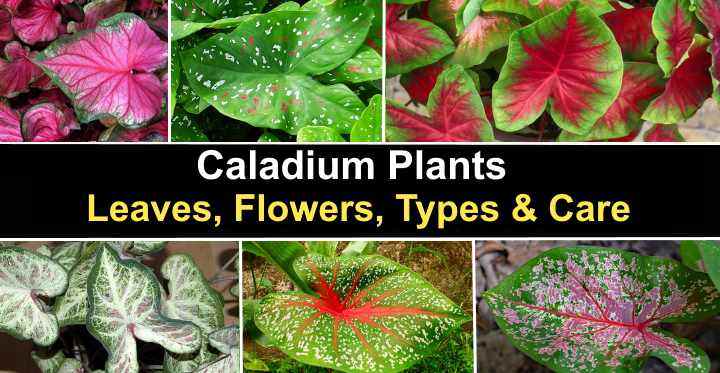Caladium plants have lovely heart-shaped colorful leaves and are stunning tropical perennials. Caladiums have stunning leaves that range in color from pink to red. Vibrantly colored veins and contrasting margins are common features of multicolored caladium plants. Sprinkles or speckles of contrasting color combinations appear on other caladium cultivars.
Caladium bicolor cultivars are the two kinds of caladiums: fancy leaf and strap leaf. The leaves of both varieties of these attractive tropical plants are arrowhead- or heart-shaped. Long stems that originate from caladium bulbs or corms produce the leaves at the end.
Some of the most stunning caladium plants are covered in this article. Deciding on the best caladium to brighten up your home décor will be aided by descriptions of the fancy leaves and pictures.
Caladium Plant Care
Grow tropical leafy plants in the shade to care for caladiums. Rich, porous soil that retains moisture but has excellent drainage is best for caladium plants. To keep the soil evenly moist, water the plants frequently. During spring and summer, fertilize every two weeks to encourage healthy, lush foliage.
Caladium Plant Facts
The genus Caladium belongs to the Araceae family of tropical foliage plants. Caladiums grow best on the shady floor of tropical rainforests in their natural environment. Caladiums, like all aroids, produce spathe-like flowers. However, they are well known for their vivid leaves.
Caladium bicolor (also known as Caladium x hortulanum) is the species that produces most cultivars with colorful heart-shaped leaves. Caladium hybrids and cultivars number in the thousands.
USDA zones 10 through 12 are ideal for growing caladiums plants outdoors. Growth requires a temperature of 65°F (18°C). Therefore, in pots outside during warm summers, you can grow caladiums as annuals or tender perennials. For shaded, humid rooms, you can grow caladiums as perennial houseplants.
The caladium plants die back in the autumn, which is a characteristic of all caladium plant growth. You can leave caladium bulbs in the ground if you live in a tropical environment. You must dig up the bulbs in the fall and store them indoors in a dark, chilly area. Don’t let temperatures drop below 55°F (13°C) for caladium bulbs to survive the winter.
Caladium varieties reach a height of 2 feet (0.6 meters) and a broadness of 2 feet (0.6 meters). The size of caladium, on the other hand, varies depending on the cultivar. Many varieties of caladiums, especially those that are compact and propagate as seedlings, flourish in most indoor settings.
Heart of Jesus, angel’s wings, and elephant ears are some of the popular names for caladiums. These colorful foliage plants are related to Alocasia, Xanthosoma, and Colocasia.
Types of Caladium
The Fancy-Leaved Caladium and the Strap-Leaved Caladium are the two most common caladium types. Broad, heart-shaped leaves on long petioles that attach close to the leaf’s center are used to identify types of fancy leaf caladiums. Narrower lance-shaped leaves with short petioles that attach to the leaf base characterize different types of strap leaf caladiums.
Caladium Leaves
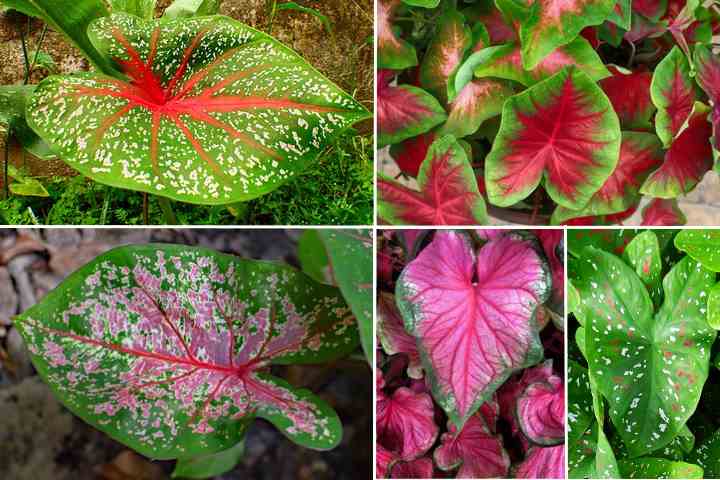
Caladium leaves range in color from light to dark and create a variety of stunning hues in any tropical habitat. The veins of both kinds of caladiums are usually prominent, vivid, contrasting, and colorful pink, red, or white midriffs with green borders.
Fancy-leaved caladiums have 6-inch (15 cm) long and 3-inch (7.5 cm) broad leaves that grow 6 to 15 inches tall. Long petioles (stems) with rounded heart leaves grow between 12″ and 30″ (30 – 76 cm) tall on the end of them. The pointed, arrowhead leaves of strap-leaved caladiums are slimmer than those of the fancier leaf types.
Ruffled borders are common on the bright, showy leaves. Strap-leaved caladiums have denser foliage that is narrower lanceolate in appearance than the wide leaves, with 12″ (30 cm) petioles at the end.
Caladium Flowers

Caladium is a tropical flower plant that bears a solitary blossom that resembles a calla lily when photographed close up. A tiny white spike (known as a spadix) is surrounded by a pink or white spathe in Caladium flowers. Caladium blooms are tiny when compared to the foliage. Caladiums, in general, don’t bloom indoors.
Caladium Bulbs
Tuberous corms or bulbs produce caladium plants. During freezing winters, caladium bulbs must be winterized indoors since they are not resistant to cold. The top of the tiny caladium bulb is rough and knobby. The rough end of the caladium bulb should face upward when being planted.
Types of Caladium Plants (With Pictures)
Let’s take a closer look at some stunning multicolored caladium plants.
Heart of Jesus Caladium (Caladium bicolor)
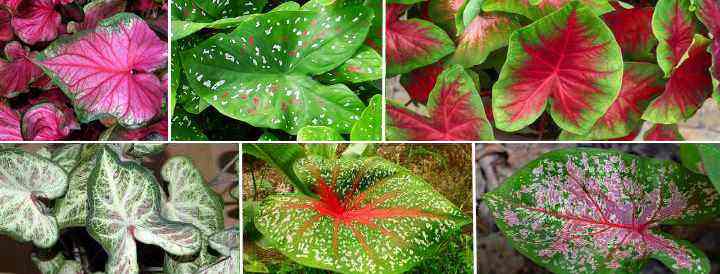
The principal species of colorful tropical plants is the ‘Heart of Jesus’ (Caladium bicolor or Caladium x hortulanum). It has thin, papery, bi-colored leaves. The various cultivars’ pointed, heart-shaped fancy leaves frequently feature stunning leaves with a variety of color and pattern combinations.
Porous potting soil that drains quickly is ideal for caladium bicolor plants. In the summer, keep the soil evenly moist by putting the caladium pot in full to partial shade and watering regularly.
Nevertheless, since the caladium bulb begins to rot in waterlogged earth, do not overwater the plant dubbed the “Heart of Jesus.” The Heart of Jesus, like all caladium varieties, dies back to the ground during the winter. You may prune the caladium’s leaves if you grow it indoors. Over the winter, keep the bulbs in moist soil so they’ll be ready to plant next spring.
Caladium ‘Florida Sweetheart’ (Caladium bicolor ‘Florida Sweetheart’)

A strap-leaved caladium with rose red heart leaves, green borders, and black pink veins, the Florida Sweetheart caladium is a popular variety. The plant’s ornamental value is enhanced by the slender, lance-shaped leaves with wavy, ruffled margins. This little compact caladium may reach a height of 6 to 12 inches (15 to 30 cm).
Any shaded area or corner of your yard will be brightened up by the green and pink arrow leaves. This species’s vibrant pinkish-red colors are preserved even when it is exposed to the sun.
Caladium ‘Red Flash’
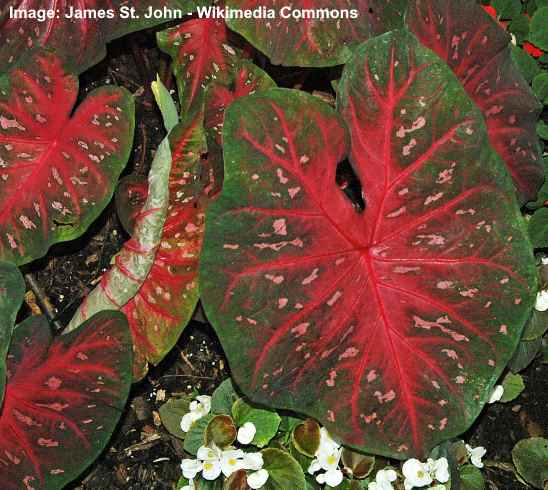
The massive, heart-shaped leaves of the Caladium ‘Red Flash’ are green, pink, and crimson. The crimson veins in the rounded olive-green leaves seem to seep into the green leaves. Pink speckling adds to the fascinating foliage patterns on the beautiful caladium leaves.
A spathe blossom appears on occasion, but it’s usually hidden by the huge leaves. The tall, delicate perennial caladium with colorful leaves is known as the fancy-leaved ‘Red Flash.’ It grows between 18″ and 30″ (45 – 76 cm) tall.
The stunning container plant’s leaves retain their vivid, indirect sunlight even though it thrives best in partial shade. The Caladium ‘Red Flash’ thrives in vibrant borders or pots outdoors.
Caladium ‘Florida Red Ruffles’

This caladium variety, also known as Florida Red Ruffles, has wavy green edges that seem to be lobed and dusty pink-reddish leaves. Pinkish-red leaves with thin green margins make up the majority of the plant’s large, pointed shiny leaves. Even when growing in strong sunlight, the tropical foliage hues last.
In sunny summer gardens, you may cultivate annual elephant ear plants called ‘Florida Red Ruffles.’ Since it doesn’t grow taller than 12″ (30 cm) tall, the gorgeous red and green container plant is also a perfect tropical houseplant for the shade.
‘Moonlight’ Caladium (Caladium bicolor ‘Moonlight’)

‘Moonlight’ caladium leaves are white, light-emitting, and grow up to 6″ (15 cm) long with green borders and veins. Caladium thrives in either bright sun or full shade, with its delicate borders matching the plant’s beauty. The thin white translucent leaves might be damaged by direct sunlight. Water this caladium frequently enough to keep the soil slightly moist.
Caladium ‘Candyland’ (Caladium bicolor ‘Candyland’)
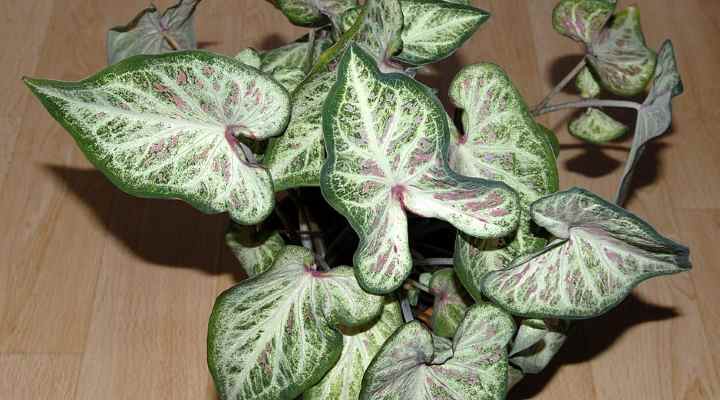
A strap-leaved caladium with green and white leaves with a hint of red and pink flecks or spots, the Candyland series is a popular cultivar. The pointed arrowhead leaves of some plants may be covered with red colors, producing them to appear crimson, white, and green.
The rippled green borders of the caladium leaves are another characteristic. The bushy leaves reach 18 inches (54 cm) tall and produce large colorful caladium leaves. It is critical to keep the soil moist but not soggy in order to prevent the long stems from wilting. Caladiums will droop after four days without water, according to research.
Fancy-Leaved Caladium ‘Aaron’
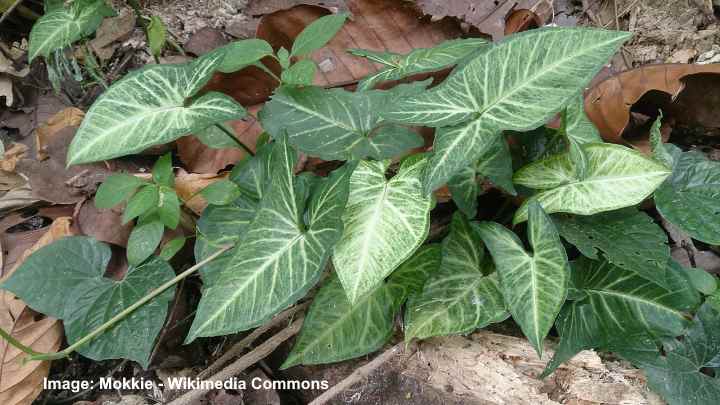
The elongated triangular green and white leaves of the Caladium ‘Aaron’ The pointed leaves have white veining that goes across the leaves and is dark to medium-green in color. The white veins merge throughout the heart leaves on some Caladium “Aaron” cultivars, giving them a white and green appearance.
The shade-loving caladium, known as the Aaron, thrives in warm soil. Too much sunlight will scorch the delicate triangular leaves, even though this caladium can withstand some. The Aaron cultivar, which is a tall, bushy caladium, thrives in containers, along shady borders, or as a tall tropical houseplant.
Caladium Lindenii

The stunning dark-green of the Caladium lindenii contrasts with silvery-white or creamy veins that run vertically and horizontally. Like the African mask plant, the plant’s leaves have striped appearance due to its creamy white veins. The petioles on this huge houseplant grow up to 3 feet (0.6 meters) tall and range from 2 to 3 feet (0.6 meters).
Indoors, maintain a room temperature of 70°F (21°C) and high humidity to develop a potted Caladium lindenii. The Caladium lindenii species is a houseplant that thrives in bright, indirect sunlight.
Caladium ‘Strawberry Star’ (Caladium bicolor ‘Strawberry Star’)

With translucent creamy-white leaves, delicate dark spider veins, and speckles of strawberry-red colors, the Caladium bicolor ‘Strawberry Star’ is a lovely ornamental plant. The foliage of this fancy-leaved caladium is created from enormous white and green heart-shaped angel wing leaves.
In any shaded nook of a room, the brilliant, appealing leaves dazzle. The 18 inch (45 cm) tall caladium variety, known as the Strawberry Star, At the end of slender petioles, the fancy triangular white, green, and pink leaves grow. To keep the soil moist, grow this unusual caladium in partial shade and water it frequently.
Caladium ‘Bombshell’

Green and crimson red leaves adorn the Caladium ‘Bombshell.’ Bright red veins run down the center and to the margins of the angel wing leaves, making them stand out. An dramatic red patch of color in the center surrounded by green borders appears to hemorrhage from the veins, giving it an intense crimson color.
A sun-tolerant caladium that thrives in the shade, the Caladium ‘Bombshell’ is a popular choice. Depending on your growing zone, you can grow the caladium known as the ‘Bombshell’ as a tender perennial or annual. In gardens or interiors, this red fancy-leaved caladium adds drama.
Caladium ‘White Dynasty’ (Caladium bicolor ‘White Dynasty’)
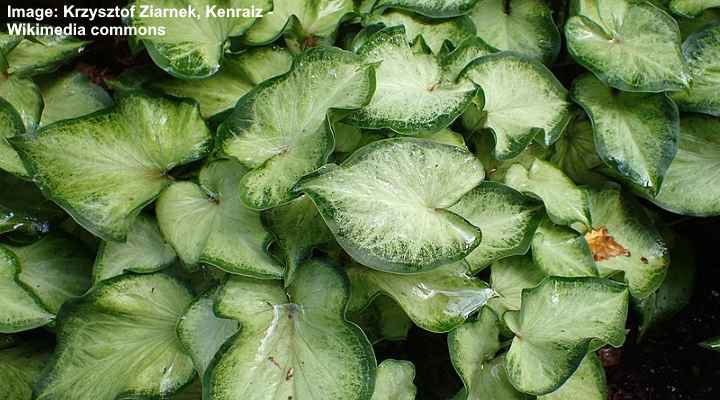
Fancy-leaf caladiums with variegated creamy white leaves and dark green borders are known as the Caladium ‘White Dynasty.’ This attractive plant’s aesthetic appeal is further enhanced by the wavy white and green leaves, which have red veining and specks.
The translucent white look of the heart-shaped leaves brightens up shaded borders or rooms, and they emerge in masses. The ‘White Dynasty’ thrives in the shade and has moist, well-drained soil as a low-maintenance caladium. Outdoor containers, hanging baskets, and as an indoor houseplant in humid rooms are recommended plantings for ‘White Dynasty’ caladiums.
Caladium ‘Carolyn Whorton’ (Caladium bicolor ‘Carolyn Whorton’)

Carolyn Whorton’s angel wings is a gorgeous foliage plant with large heart-shaped green, red, and pink leaves. Dark green borders and deep pink or crimson veins characterize the vivid pink leaves. Smaller flowers, such as those of the calla-lily, may bloom indoors on occasion.
The Carolyn Whorton, like many pink and green caladiums, is resistant to the sun. To brighten sunny borders or add color to patios, decks, and balconies, grow the caladium ‘Carolyn Whorton. Caladium is a beautiful indoor tropical houseplant that grows between 1 and 2 feet (30 and 60 cm) tall.
Caladium bicolor ‘Thai Beauty’

A strap-leaf caladium with stunning pink and green leaves with green or occasionally white veins, the Caladium bicolor ‘Thai Beauty’ is a beauty to behold. The intricate network patterns on the unusual pointed pink leaves seem hand-painted.
Among the Caladium bicolor species, the variegated triangular leaves are some of the most gorgeous. Planting it in a loose, porous soil mix will allow you to grow ‘Thai Beauty’ as a perennial houseplant.
To keep the growing medium moist throughout the season, water it regularly. Prune the caladium leaves down to the ground in the winter, and place them in a temperature of 50°F to 55°F (10 – 12°C). To encourage the gorgeous tropical plant to regrow, replant the caladium bulbs in fresh potting soil in early spring.
Angel Wings ‘White Queen’ (Caladium ‘White Queen’)

The magnificent broad white leaves with green borders and crimson veins on the Caladium ‘White Queen’ are stunning. Any tropical garden or indoors will benefit from the ornamental foliage’s stunning focal point. Caladium may be planted in a shaded area and grows to 18-24″ tall (45–60 cm).
Angel Wings ‘Miss Muffet’ (Caladium ‘Miss Muffet’)
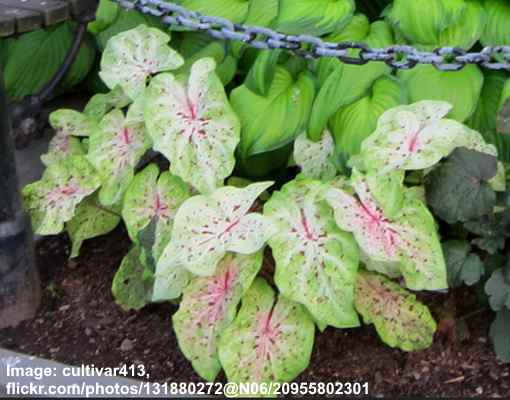
Heart-shaped light green leaves with dark pink splashes characterize the caladium known as “Miss Muffet.” This caladium cultivar has smaller leaves and stems and grows up to 12 inches (30 cm) tall.
This dwarf caladium can tolerate some indirect sun and thrives in shaded or partly shaded areas. Caladiums with their stunning foliage can be used in garden beds, pots, along walkways, borders, or as houseplants.
